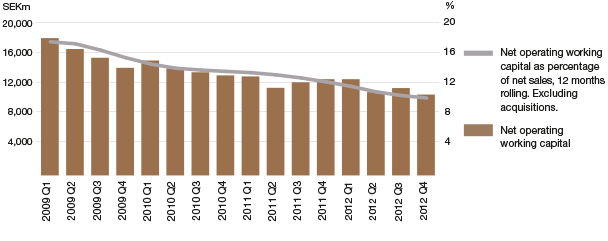In recent years, Electrolux has worked intensively to reduce tied-up capital in the Group. In addition to Group-wide measures to streamline and optimize manufacturing, each business area is focusing on improving working capital to free up resources that can instead be invested in growth activities.
Net operating working capital

Net operating working capital as a percentage of net sales, excluding acquisitions, have declined from about 18% 2009 to 10% 2012.

The Electrolux working capital program ...
Improving working capital is a prioritized area at Electrolux. The work is conducted in the form of a Group-wide program with a dedicated organization. Activities are ongoing in all parts of the Group to improve working capital in such areas as sales, marketing, procurement, manufacturing and administration. Furthermore, the Group's remuneration model for managers has clear targets linked to capital efficiency. The program to improve working capital focuses on efficiency-enhancement measures in primarily four areas:
• Trade receivables – invoicing process, payment terms and handling of overdue receivables
• Accounts payable – payment terms, invoice processing and payment routines
• Inventory – optimization of inventory levels, review of product range, process improvements within operations and sales organization
• Procurement – enhance synergies and coordination between units.
... has yielded clear results ...
The working capital program has generated increased profitability through higher efficiency and reduced complexity in operations. Inventory levels have been optimized and processes for administration of invoices and accounts payable ledger have been improved. The program has also yielded an increase in the capital turnover-rate excluding acquisitions, and increased the employees' understanding of the business, resulting in more reliable sales forecasts and an improvement in the service level to retailers.
... and freed up resources for investments in new products ...
A reduction in the structural working capital – the portion that is not impacted by the global economy – combined with higher margins has strengthened cash flow and thus also the balance sheet. This has created more resources for investments in growth-promoting activities. In 2012, Electrolux investments in product development and marketing accounted for 1.9% and 1.7%, respectively, of sales. It will be possible to increase this share further in the years ahead.
... but continued discipline will be required in better times.
As sales increase, it will be necessary to have an even stronger focus on limiting the capital intensity. The global initiatives taken by Electrolux to enhance synergies and leverage economies of scale will facilitate this work.
Structural change of capital expenditure
 |
Going forward, capital expenditure will structurally change and be more related to development of new products. |
